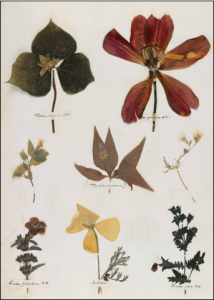Revealing Emily Dickinson’s Life
Posted in Exhibitions on June 3 2010, by Plant Talk
Gallery Exhibition Delves into Poet’s Love of Nature
 |
Judith Farr is Professor Emerita of English and American Literature at Georgetown University and author of The Passion of Emily Dickinson and The Gardens of Emily Dickinson. |
 It is not widely known that our great American poet Emily Dickinson (1830–1886) was a practiced gardener before she became an accomplished poet. She joined her gentle mother tending the classic contents of a cottage garden—roses, cyclamen, lobelia, tulips, and more—at only 12 years of age while her training under the famous New England educator Edward Hitchcock taught her the elements of botany in childhood.
It is not widely known that our great American poet Emily Dickinson (1830–1886) was a practiced gardener before she became an accomplished poet. She joined her gentle mother tending the classic contents of a cottage garden—roses, cyclamen, lobelia, tulips, and more—at only 12 years of age while her training under the famous New England educator Edward Hitchcock taught her the elements of botany in childhood.
Indeed, nearly half of Dickinson’s lyrical letters to family and chosen friends and over one-third of her brilliantly idiosyncratic poems appeal to nature for the images and themes that render them incisive and unforgettable. Only a few of Emily Dickinson’s poems were printed during her lifetime but many people remembered receiving one of them, often tucked into an exquisite bouquet that she had grown and arranged herself.
Therefore, it is fitting that The New York Botanical Garden presents Emily Dickinson in her reciprocal roles as Poet and Gardener in its exhibition Emily Dickinson’s Garden: The Poetry of Flowers. While an array of the flowers about which she wrote blooms outdoors at the Garden, the LuEsther T. Mertz Library Gallery showcases materials designed to introduce visitors to the life and art of Emily Dickinson. The Gallery Exhibition, which will run to August 1, is built around several significant themes in Dickinson’s life, such as her childhood, her gardening, and her poetry.
A facsimile portrait of Dickinson, her brother Austin, and sister Lavinia as well as an engraving she especially admired from Mrs. Clarissa Munger Badger’s Wild flowers drawn and colored from nature help depict her early years.
As a teenager, Dickinson created a 400-specimen herbarium, collecting and pressing flowers into an album that is digitized and can be “flipped through” on a touch screen in the exhibition. (The image at top is from the digital facsimile of Emily Dickinson’s Herbarium, by permission of the Houghton Library, Harvard University; a facsimile edition of Emily Dickinson’s Herbarium is available from Harvard University, MS Am 1118.11.) The jasmine appears on page one of her herbarium. Mid-Victorians believed that each flower or plant had a symbolic meaning, and the exhibition explores this with images and text, including Symbolical Language of Flowers, written by Dickinson’s teacher, Mrs. Almira H. Lincoln. For Dickinson the jasmine meant “passion” while to give someone a jasmine vine meant, “You are the soul of my soul.” Dickinson would often imply and include these meanings in the poems she wrote or the bouquets she sent.
It was the editor of The Springfield Republican, Samuel Bowles, who gave Dickinson a jasmine vine that she kept alive for decades. Again, it was Bowles who called Emily “Daisy,” his “Queen.” By then, she was wearing the white dress (a reproduction which is also in the exhibition) that may have signified her marriage to the Muse, her artist’s self-consecration.
Dickinson the gardener and her favorite flowers are represented in the exhibition by engravings of the gentian, the crown imperial, the geranium, the rose, and the Indian pipes that her friend Mabel Todd painted to adorn the cover of the first edition of Dickinson’s poems in 1890. The daylily that Dickinson compared to herself (red like her auburn hair) also appears in an engraving. A watercolor of the “Ox-eye Daisy” is shown together with two stunning biographical entries: A poem “The daisy follows soft the sun,” which was written for a man, an imagined lover, called “Master” and the famous second, unsent letter to “Master” in which Emily/Daisy yearns for “the Queen’s place” next to him at night. These fascinating and compelling objects are at the heart of what so many think of (and often much too crudely represent) as the “mystery” of Dickinson’s life.
In her 30s she became reclusive and for the rest of her life stayed mostly at home, the Homestead, which is shown in an 1858 black-and-white lithograph as well as a recent color photograph.
The subject that runs throughout the exhibition—the cultivation of flowers—makes clear that, although her poetry is boldly original and even “modern” in so many of its attributes such as intense compression, ellipsis, and off-rhyme, Emily Dickinson was a woman who lived in the Victorian age. Women then were expected to be not only what English poet Coventry Patmore called “the Angel in the House” but the Muse of the Garden as well. Emily Dickinson, then, had two vocations. Thanks to The New York Botanical Garden, it is not only as a poet that we may know her this spring.

